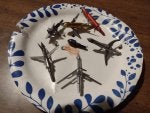I’m bored lol. And I admit I have did this myself for myself before. I have read how helical and spin vanes rob you of speed and cast of the arrow. So I decided to recreate the test I did years ago with different vanes that I used today but the results were the same.
First I used 3 spynal tapps bought off Jerry when he was at south shore. I fletched each arrow myself, the Nap hellfire (spinner vane) and the slight right offset vantec HD 2” vane with the firenock jig straight clamp. The orange vantec I used the same jig but used a modified blitz right helical clamp. All the arrows were also shot tuned they needed no correction.
There was a slight wind. First I shot the straight slight off set vane. Then the orange helical arrow then lastly the Hellfire spinner vane.
All the shots were made at 50 yards. Here is what the target recorded.
![Image]()
The two vantec fletched arrows weighted 434 (I just weighted one). The Hellfire vane weighted 445 so 11 grs heavier. The bow was a Excalibur matrix BD 360. So at least on my range speed robbing arrow spinning is debunked.
First I used 3 spynal tapps bought off Jerry when he was at south shore. I fletched each arrow myself, the Nap hellfire (spinner vane) and the slight right offset vantec HD 2” vane with the firenock jig straight clamp. The orange vantec I used the same jig but used a modified blitz right helical clamp. All the arrows were also shot tuned they needed no correction.
There was a slight wind. First I shot the straight slight off set vane. Then the orange helical arrow then lastly the Hellfire spinner vane.
All the shots were made at 50 yards. Here is what the target recorded.
The two vantec fletched arrows weighted 434 (I just weighted one). The Hellfire vane weighted 445 so 11 grs heavier. The bow was a Excalibur matrix BD 360. So at least on my range speed robbing arrow spinning is debunked.







